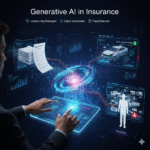Introduction to Autonomous Vehicles
Autonomous vehicles (AVs), often referred to as self-driving cars, represent a significant technological advancement in the automotive industry. Defined as vehicles capable of sensing their environment and operating without human intervention, AVs leverage a combination of sensors, cameras, radar, and artificial intelligence to navigate roads and respond to dynamic driving conditions.
The current state of autonomous vehicle technology is diverse, spanning several levels of automation as defined by the Society of Automotive Engineers (SAE). These levels range from Level 0, where the driver performs all tasks, to Level 5, which describes fully autonomous systems capable of managing all aspects of driving without human input. While many contemporary vehicles feature Level 2 automation, incorporating advanced driver assistance systems (ADAS) such as adaptive cruise control and lane-keeping assistance, the industry is rapidly progressing towards higher levels of autonomy.
Key players in the AV industry include tech giants like Google’s Waymo, automotive manufacturers such as Tesla and General Motors, and numerous startups specializing in autonomous technology. Recent advancements have seen significant milestones, including Waymo’s deployment of driverless taxis in select cities and Tesla’s rollout of its Full Self-Driving (FSD) beta to a wider audience. These developments underscore the accelerating pace at which autonomous vehicle technology is evolving.
The potential benefits of widespread AV adoption are substantial. Improved safety is a primary advantage, as autonomous systems can reduce human error, which is a leading cause of traffic accidents. Additionally, AVs hold the promise of alleviating traffic congestion by optimizing traffic flow and reducing the need for parking spaces in urban areas. However, the transition to autonomous vehicles is not without challenges. Ethical concerns, such as decision-making in unavoidable accident scenarios, and the integration of AVs with existing traffic systems, present significant hurdles. Moreover, the regulatory landscape and motor insurance frameworks need to adapt to address the unique risks and liabilities associated with AVs.
As the journey towards fully autonomous vehicles continues, understanding these fundamental aspects is crucial for stakeholders, including consumers, policymakers, and insurers, who must navigate the evolving landscape of motor insurance and autonomous vehicle insurance.
Impact of Autonomous Vehicles on the Insurance Industry
The advent of autonomous vehicles is poised to revolutionize the insurance industry by significantly altering the traditional paradigms of motor insurance. A key transformation lies in the shift of liability from human drivers to vehicle manufacturers and software developers. As autonomous vehicles (AVs) minimize human intervention, the question of accountability in the event of an accident becomes more complex, necessitating a reevaluation of existing insurance models.
One of the primary areas of change will be in policy underwriting. Traditional motor insurance policies are based on the assumption that human error is the primary cause of accidents. However, with autonomous vehicles, fault determination might increasingly point towards technological failures or software malfunctions. This shift will likely lead to a different approach in underwriting policies, focusing more on the reliability and safety records of the vehicle’s technology and its manufacturers.
Premium calculations will also undergo substantial modifications. Currently, premiums are largely determined by the driver’s history, age, and driving habits. With AVs, the emphasis will shift towards the vehicle’s software and hardware performance, safety features, and the track record of the manufacturers. Consequently, risk assessment models will need to be redefined to accommodate these new variables, potentially leading to lower premiums for AVs equipped with advanced safety systems.
Insurance companies will need to adapt by developing specialized products and services tailored to the specific requirements of AV owners and operators. This includes comprehensive coverage that addresses software glitches, cyber threats, and product liability. Additionally, insurers might offer coverage for data breaches and other cybersecurity risks, given the connected nature of autonomous vehicles.
The emergence of autonomous vehicles compels the insurance industry to evolve and innovate. Insurers will need to stay abreast of technological advancements and regulatory changes to effectively meet the unique challenges and opportunities presented by this transformative shift. This dynamic landscape will require a collaborative effort between insurers, manufacturers, and regulators to ensure that motor insurance remains relevant and robust in the era of autonomous vehicles.
Regulatory and Legal Considerations
The rapid advancement of autonomous vehicle (AV) technology necessitates a robust and dynamic regulatory and legal framework. Currently, regulations governing autonomous vehicles vary significantly across local, national, and international jurisdictions. At the local and national levels, governments are beginning to establish guidelines to address the unique challenges posed by AVs. For instance, in the United States, the Department of Transportation (DOT) and the National Highway Traffic Safety Administration (NHTSA) have issued guidelines to ensure the safe deployment of AVs. Similarly, the European Union has implemented policies that require rigorous testing and certification processes for autonomous vehicles.
As AV technology continues to evolve, so too must the regulatory landscape. One critical area of focus is the establishment of clear liability frameworks. Determining who is at fault in an accident involving an autonomous vehicle presents a complex challenge. Traditional motor insurance models, which typically place liability on the driver, may no longer be applicable. Instead, new models that consider the role of software developers, AV manufacturers, and even data providers are being explored. These frameworks aim to ensure that victims receive fair compensation while encouraging innovation and safety within the industry.
Government agencies play a pivotal role in creating and enforcing these policies. They must balance the need for stringent safety standards with the desire to foster technological advancement. This often involves collaboration with various stakeholders, including insurance companies and AV manufacturers. By working together, these entities can influence regulatory decisions to create a safer and more equitable environment for the deployment of autonomous vehicles.
Insurance companies, in particular, are actively engaged in shaping the regulatory landscape. They are developing new insurance products, such as autonomous vehicle insurance, that are specifically designed to address the unique risks associated with AVs. These products often involve innovative approaches to risk assessment and premium pricing, which are informed by data collected from AVs. By collaborating with regulators and AV manufacturers, insurance companies are helping to ensure that the regulatory framework keeps pace with technological advancements, ultimately contributing to the safe and widespread adoption of autonomous vehicles.
Future Trends and Predictions
The landscape of autonomous vehicle (AV) technology is rapidly evolving, with significant implications for the motor insurance industry. As AVs continue to develop, several emerging trends and innovations are poised to shape the future significantly. One of the most anticipated developments is the widespread adoption of AVs in urban areas. This shift could lead to a reduction in traffic congestion and accidents, ultimately lowering the risk profile for insurers. Consequently, motor insurance premiums may decrease, reflecting the enhanced safety features inherent in AV technology.
In addition to urban adoption, changes in personal and commercial vehicle ownership models are expected. The rise of shared mobility services and fleet-operated AVs could transform how individuals and businesses view vehicle ownership. This transformation may prompt insurers to develop new products tailored to these evolving needs, such as usage-based insurance or fleet insurance policies. Such products would align more closely with the dynamics of a shared economy, offering flexibility and cost-effectiveness to customers.
Another critical aspect of the future landscape is the integration of AVs into smart city infrastructures. As cities become smarter, AVs will likely play a crucial role in enhancing urban mobility and connectivity. These intelligent systems will require sophisticated data analytics and cybersecurity measures to ensure safety and efficiency. Insurers will need to adapt by incorporating advanced technologies such as AI and blockchain to manage risk assessment and claims processing more effectively.
Industry experts and thought leaders offer various insights into how these trends might shape the future. They predict that the convergence of AV technology and insurance practices will lead to more personalized and dynamic insurance solutions. For instance, real-time data from AVs could allow insurers to offer immediate adjustments to coverage based on driving conditions and behaviors. Furthermore, advancements in machine learning and telematics will likely enable predictive analytics, improving risk management and policy pricing.
In conclusion, the future of autonomous vehicles and motor insurance is intertwined, with technological advancements driving both industries forward. The widespread adoption of AVs, changes in ownership models, and integration into smart cities will necessitate innovative insurance solutions. As these trends unfold, the motor insurance landscape will continue to evolve, offering new opportunities and challenges for all stakeholders involved.










